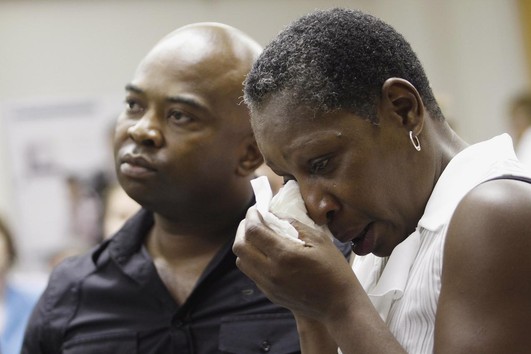Preventing the Undesirables: Forced Sterilization & Eugenics in the US and Abroad
If you enjoy the luxury of living under a rock, you may have missed the news that the planet’s population has reached (and now exceeded) seven billion people. The media made quite a fuss about it, briefly rocketing the issue of population control ahead of the economy and unemployment rates.
What is alarming about so many of these conversations is that the United States is constantly compared to other nations – namely China and India, each of which has over three times the population of the US. There are obvious political undertones to the ways in which population statistics from “over there” are presented to the masses here. Media coverage is focused on escalating quantity, not on generating outrage about the massive inequalities that exist in China and India. Blatant acts of gender violence (e.g., rape, female infanticide, acid throwing), poverty, wars, foreign policy, and environmental injustice in other countries, or here, typically do not inspire discussion of family planning or educating women and men about contraception options.
Instead, contemporary rhetoric about population control mimics the ways in which the United States feared the growing population of the Soviet Union during the Cold War. More births in the “second world” meant more little Communist babies on earth, walking around saluting Brezhnev, Castro, and manifestos. Cold War fears and ideologies were mapped onto the bodies of Soviet babies, positioning them as a source of geopolitical conflict. At the same time, the U.S. was awash in similar attitudes toward some American babies (and potential babies) of women who did not fit the mold of the ideal citizen (e.g., white, middle-class, non-disabled). Influenced by a century of eugenics and an emerging population control establishment, women and girls of color, poverty, or an “unsound mind” (those deemed mentally unstable or “feeble”) were susceptible to forced sterilization by their state governments.
The process was legal for nearly 50 years in this country and practiced in over 30 states. North Carolina was the last state to outlaw the horrendous practices, but not until 1974. Universities, private medical institutions, and the government all played a part in sterilizing over 7,000 women and men in North Carolina alone. Today, in that state, just 48 victims of the state’s eugenics program are alive. They are bravely telling their stories to the state government and the public as they await decisions on reparations – likely to be in the range of $20,000-$50,000 each. As North Carolina victims share emotional memories of their experiences, we witness the trauma caused when population control efforts wind punitively through communities.
We have heard the story of Elaine Riddick who was raped by a neighbor at the age of 13 and conceived her rapist’s child. Too young to understand the complicated process of reproduction, her young body experienced debilitating pains nine months later and she gave birth to a baby boy. Without her knowing, doctors immediately rolled her into another room, still anesthetized, and sterilized her. She awoke hours later, not even aware of what had been done to her, physically or emotionally. The doctors did not tell her after the sterilization, either. It took years for her to understand that on the day she gave birth to a baby conceived in sexual violence, doctors also ensured she’d never experience childbirth again. This woman was not only robbed of her dignity, but of the opportunity to determine whether she wanted to experience childbirth, on her own terms. There is no dollar amount that can capture the loss this woman has experienced.
This issue hits in very personal ways for many women. Had I lived in North Carolina in the 1960s, I would have been an ideal candidate for their eugenics program. Although I am Caucasian and never lived in abject poverty, I was diagnosed with a mental illness at a young age and even received outpatient treatment to help the doctors understand my conditions. I have little doubt that in North Carolina, there would have been an effort to prevent someone like me from reproducing in the future. If I burdened society as a child, just imagine what my offspring would be like. My parents could not have protected me: like so many victims of forced sterilization, I simply would have been taken from their arms, strapped down, and given enough medicine to sleep through the procedure. I would have awoken, as too many others did, castrated by the hands of my own government.
Unfortunately, as the North Carolina hearings and numerous other instances show, discussions of “population control” have not advanced to where they ought to be. They are still, today, as problematic as the history behind the family planning movement in the United States. The idea that population control should correlate with liberating women, rather than with state needs or eugenics beliefs, is still a radical notion. In the U.S., birth control methods were first introduced to control the growing immigrant families arriving from Europe. Irish, Italian and German women were particularly targeted for receiving contraceptives and abortion procedures. The idea that contraception can be liberating when used by women who desire the ability to limit the number of children came later, as the women’s movement advanced. To take just one example, Planned Parenthood has come a long way from its dubious origins in the work of Margaret Sanger (who championed the Negro Project, among other strategies), to its current status as one of the country’s chief reproductive rights NGOs.
Yet liberation through contraception is still not reaching our sisters in poor regions of the world, nor many of our sisters in certain parts of the United States. This seems like a questionable statement, doesn’t it? After all, countless agents (churches, local and international governments, advocates, and pharmaceutical companies) work in regions around the world to prevent population growth and the inevitable poverty and harm that comes from overpopulated communities. At the heart of these efforts, though, we must ask the million-dollar questions: Are these agents truly motivated by the liberation of individual women, or women as a class? If reproduction options are available in one poor region of the world, why aren’t they available in all poor regions of the world? And why aren’t these options equal, and equally accessible, across the board? Why is there motivation, for example, to offer abortion services in India, but not in rural Ghana?
We don’t name contemporary population control efforts eugenic because it is difficult to determine if organizations and states are, in fact, deliberately trying to prevent the births of particular populations. Due to infamous eugenics movements history (the Holocaust is our most extreme example), we think of eugenics in very large-scale, targeted, publicized ways. Eugenics is also understood to be efforts that are forced on individuals, rather than enthusiastically welcomed. Often international measures to offer birth control are graciously accepted by desperate women around the world, who understandably cannot fathom the idea of watching another child die before the age of five. But eugenics can operate in subtle ways, and often be unnamed. By unequally offering family planning options to women throughout the world, by encouraging some women to reproduce while prohibiting others, we begin to model historical eugenics programs.
If the United States is threatened by growing populations in India, for example, or anywhere else with “teeming masses,” then abortion services will continue to be available and well funded to Indian women. If services are unequal in any way, the haunting stories of eugenics victims in the United States resonate at the international level. This hardly transforms the rhetoric of population control to one of female liberation and freedom from coercion. Political security, religious interests, and profit once again mark the bodies of women. Perhaps the best way we can respect and honor the experiences of sterilization victims in the United States (and elsewhere) is to collectively ensure women throughout the world are not subjected to similar practices. Because we allowed sterilization abuse to happen at all here, we have a social obligation to be critical of current global reproductive practices, and to guarantee such injustices do not assault other communities around the world. We have an obligation to name practices as eugenic when they embody historic notions of “betterment” and foster inequality.
We cannot repair the past, but we can work collectively to ensure a more just future.
_________________________________________________________________
Catherine Morrisey is a graduate student at Arizona State University studying Social Justice & Human Rights. Her interests include mental health rights, global health movements, immigration and the construction of nationality, and food politics. She is currently working on a project documenting the lives of children institutionalized for mental illness. She lives in Arizona with her husband and four children, all of whom are actually pets (except her husband).








4 Comments